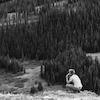January 26, 2015 - 21:28

I've wandered around Ryan Pinetum before today, but not attentively. For the past year and a half, when I would find time to visit the Pinetum, I would walk around the field, staying in the semi-designated walking paths, or sit on a bench (one of the many) and look around the field from beneath a tree. On this walk, I weaved among the conifers' green branches now weighed down with snow. Spruces and pines have been a backdrop to many of my experiences in the outdoors. They remind me of mountains, of tangled undergrowth and cold winters, of home. Being close to the trees, I would rub a few needles in between my fingers and press them to my nose to look for that familiar scent.
After reading about the College's regular cultivation of exotic species, I chose to carefully read the labels (courtesy of the Arboretum) and paid close attention to their names and origins. I was surprised (pleasantly? unpleasantly? I'm still not sure) at their wide diversity: not their genus/species types, but their original location and range. Many of them are native to Japan, China, Eurasia. These trees, thoroughly different from others on campus, are a living example of ideologies that once put special emphasis on a particular concept of what is ornate, flashy, different—over other apparently dull or nonexistent counterparts already living here. While reading about William Carvill's vision for the campus, a beautiful campus with exotic species built on farmland, I couldn't help but think back Jamaica Kincaid's description of English gardens in “Alien Soil.”
It feels strange now that my connection to this very broad category of “conifers” is put into a little more context. I associate evergreens so strongly with home, but many of those in the Pinetum, while biologically close in family, are not geographically near to the ones I grew up with. I thought I “knew” these trees. They seemed so familiar, and maybe even fitting in this setting. Yet each tree each was hand-picked, preserved, and nurtured by people for the purpose of biological diversity, each considered specimens in a “scientific collection,” pretty transplants from elsewhere—not for preserving what was already close to home. Somehow that geographic dissonance—the fact that these species were from so far away, yet seemed to be thriving here—made watching a red-tailed hawk fly out of an Oriental Spruce slightly strange, if not a bit comical. But why is it so strange? Isn't that what this land has been made into—transplants, people and things from elsewhere? By the time I reached the tree the hawk flew from and held its needles up close, the scents on my fingers from two trees before already blended together with this one.
—
Haverford Arboretum history: http://www.haverford.edu/arboretum/collections/history.php
Ryan Pinetum history: http://www.haverford.edu/arboretum/collections/pinetum_tour.php
Ryan Pinetum tree tour: http://www.haverford.edu/arboretum/files/pinetum-tour-map.pdf
